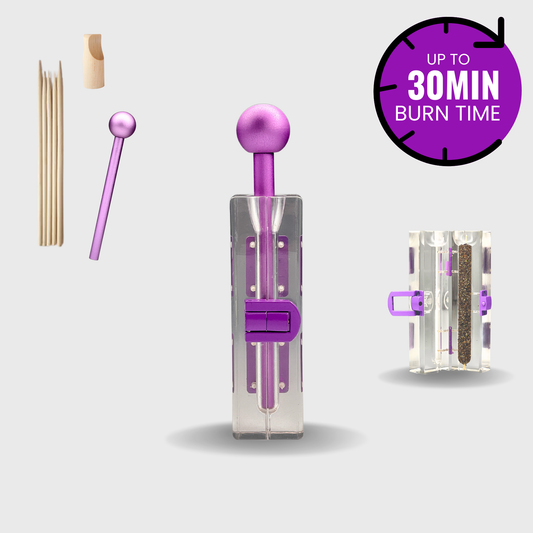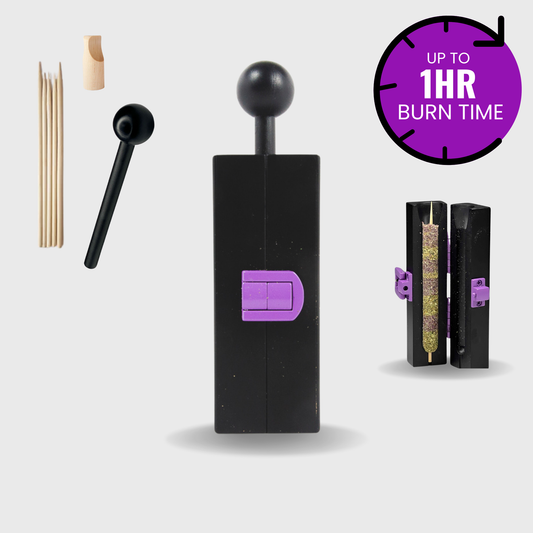⬇️ Prefer to listen instead? ⬇️
- Full-spectrum cannabis may be more effective than THC or CBD isolates for pain and epilepsy, though data is limited.
- Scientific evidence of the entourage effect remains inconclusive but promising.
- Terpenes like myrcene and limonene might influence cannabis effects beyond flavor and aroma.
- Most research comes from animal studies, leaving human effects largely unverified.
- Cannabis product marketing often claims entourage benefits without rigorous scientific backing.
You’ve probably heard the hype—cannabis strains that promise to spark creativity, knock you out cold, or help you “vibe higher." Many of these claims point to one idea: the entourage effect. This concept suggests it’s not just THC or CBD doing the work, but the whole band of compounds in cannabis playing together to shape your experience. But is it rooted in real science, or just clever branding? Let’s look at what we actually know—and how it can shape your next smoke session.

Where Did the Entourage Theory Come From?
The term “entourage effect” wasn’t coined by cannabis marketers—it first appeared in a 1998 paper by Israeli researchers studying the endocannabinoid system (ECS), the internal network in our bodies responsible for maintaining physiological balance. These scientists, Raphael Mechoulam and Shimon Ben-Shabat, noticed that some endogenous cannabinoids (those naturally produced in the human body) weren’t effective on their own. Surprisingly, when combined with other compounds, these previously inactive molecules began showing biological activity.
This discovery raised a fascinating question about cannabis: could the same principle apply to phytocannabinoids (plant-based cannabinoids)? That is, instead of THC or CBD working solo, might cannabis compounds work in concert to enhance or moderate the plant’s effects?
This idea gained traction quickly. By the early 2000s, researchers and enthusiasts alike started looking into how interactions between THC, CBD, minor cannabinoids, and even terpenes might explain the plant’s different effects. Which is why today, the word “entourage” has become a buzzword—from dispensary brochures to scholarly articles.
Fun fact: The original entourage effect wasn’t about weed at all—it came from studying the brain’s own cannabinoid system.

What’s Inside the Plant? (And Why It Matters)
Cannabis is far more than its most famous molecules. Each plant contains a rich chemical profile that contributes to its therapeutic and recreational effects. While THC and CBD get the spotlight, there are hundreds of other bioactive compounds that may play a role in what you feel.
Primary Cannabis Compounds
-
THC (Delta-9-Tetrahydrocannabinol): The primary psychoactive component responsible for the cannabis "high." It binds to CB1 receptors in the brain, producing euphoria, altered sensory perception, increased appetite (the munchies), and sometimes anxiety or paranoia in higher doses.
-
CBD (Cannabidiol): Unlike THC, CBD has no intoxicating effects. Instead, it’s known for its anxiolytic (anxiety-reducing), anti-inflammatory, and anticonvulsant properties. Some studies suggest CBD may help buffer THC’s psychoactivity, reducing associated anxiety or paranoia for some users.
Terpenes: More Than Just Aroma
-
Myrcene: Earthy and musky, myrcene is the most common terpene in modern cannabis. It may contribute to the “couch-lock” effect by enhancing THC’s sedative influence. Some studies suggest myrcene may also help other compounds more easily cross the blood-brain barrier.
-
Limonene: Bright and citrus-scented, limonene may improve mood and reduce stress. Preliminary research links this terpene to anti-anxiety and antioxidant properties.
-
Pinene: With its fresh pine aroma, pinene may offer cognitive benefits, including improved focus and memory retention. It also has anti-inflammatory potential.
-
Linalool: Found in lavender and other aromatic plants, linalool is believed to bring calming and sedative qualities. It may play a role in reducing anxiety and promoting rest.
Beyond cannabinoids and terpenes, cannabis contains flavonoids (with antioxidant properties), esters, and numerous other trace compounds that may contribute to overall effect and therapeutic potential. Together, these elements make cannabis incredibly chemically diverse—and that complexity lays the groundwork for the entourage effect.

Do These Compounds Actually Work Together?
Anecdotally, many seasoned cannabis users report that whole-plant products provide deeper, more nuanced effects than single-compound formulations. Whether it’s a broader range of therapeutic benefits or a richer high, full-spectrum cannabis seems to “do more” than THC or CBD alone.
Here are some insights into how cannabis compounds may interact:
Cannabinoid-Cannabinoid Synergy
CBD and THC offer the most studied interaction. While THC binds strongly to CB1 receptors to produce psychoactive effects, CBD does not. Instead, CBD is thought to modulate THC’s impact. Some research suggests that CBD reduces THC’s anxiety-inducing or memory-impairing side effects, resulting in a smoother experience.
Another example includes CBG (Cannabigerol), known as the “mother cannabinoid” because it’s a precursor to several cannabinoids. CBG may have neuroprotective and anti-inflammatory properties, and may also influence how other cannabinoids interact with the ECS.
Terpene-Cannabinoid Synergy
The mix of terpenes present in a cannabis strain—the “terpene profile”—can dramatically influence the subjective experience.
- Myrcene + THC: May intensify sedation and relaxation.
- Limonene + CBD: Proposed to complement anxious or depressive states with uplifting effects.
- Pinene + THC: Might counteract THC’s memory disruption and improve alertness.
Although these interactions aren’t yet fully supported by clinical trials, early animal studies and user reports still suggest that terpenes and cannabinoids working together can change how cannabis affects the brain and body.

What Does the Science Say?
The science around the entourage effect is both promising and filled with caveats.
Researchers have found that full-spectrum cannabis extracts—the kind that contain a wide array of cannabinoids and terpenes—appear to be more effective in certain therapeutic uses.
Examples From Research
-
Chronic Pain: A 2011 study found that cannabis extracts that included both CBD and THC provided more effective pain relief than THC alone.
-
Epilepsy: Doctors treating pediatric epilepsy found that full-spectrum CBD-rich extracts were more effective—and required smaller doses—than purified CBD to manage seizures in children.
-
Cancer Pain: Full-spectrum products have shown greater long-term pain control with fewer side effects, likely due to the buffering effects of other cannabinoids and terpenes.
However, it's critical to note:
- Most studies are preclinical (conducted in animals or petri dishes), and don’t always translate to humans.
- Clinical human studies often use different cannabis products with variable standards, making results hard to compare or replicate.
- There’s no consensus yet on dosing, formulation, or which specific combinations provide the best results.
Despite the buzz, science hasn’t nailed down why or how these compounds work better together. That doesn't mean synergy isn’t real—it just means we don’t fully understand it yet.

Marketing vs. Meaningful Differences
Walk into any dispensary and you'll see products labeled as:
- Full-spectrum: Contains a wide range of cannabis compounds, including THC, CBD, and terpenes.
- Broad-spectrum: Similar to full-spectrum, but typically THC-free.
- Isolate: Pure cannabinoids, typically 99%+ CBD or THC with no other compounds.
While these labels are helpful, they’re also highly marketable. Many cannabis companies reference the entourage effect as a selling point, despite a lack of specific, product-based evidence.
It’s a frustrating gray area: marketing that leans heavily on scientific theory without the rigorous studies to confirm product-specific claims.
As a consumer, don’t ignore these distinctions—but pair them with your own trial-and-error experiences, observations, and (if possible) lab-tested terpene profiles.

Why Full-Spectrum Cannabis Still Appeals
Many patients and enthusiasts continue to swear by full-spectrum products, and for good reason.
-
Therapeutic Users: Patients dealing with chronic pain, sleep issues, or anxiety may find full-spectrum cannabis to be more effective due to multi-pathway effects—where one set of compounds works on inflammation, another on sleep, and another on pain signaling.
-
Recreational Consumers: Complex highs are often favored over one-note experiences. Layered blends can offer euphoria followed by relaxation, or initial motivation followed by a winding-down calm.
The appeal lies not just in stronger effects, but more tailored ones. Full-spectrum products create a versatile toolkit that isolates simply can’t match—at least according to both patients and enthusiasts.
It’s Not Just the THC %
You’ve probably heard this before, but it’s worth repeating: percentage doesn’t equal potency—or at least not the kind that matters most.
Two cannabis flowers can have the same THC content but feel vastly different due to:
- Terpene profiles
- Minor cannabinoids like CBG or THCV
- Method of consumption
- Your own tolerance and endocannabinoid system
Instead of shopping solely for high THC percentages, focus on how the combination of cannabis compounds affects your body and mind. This could mean choosing a 17% THC strain with the right balance of myrcene and pinene over a 25% THC product that leaves you anxious or overstimulated.
Why Purple Rose Supply Believes in Rolling With Intention
We believe the way you consume your cannabis affects which compounds you preserve—and how your body absorbs them.
Our CannaMold system is designed to:
- Help preserve terpene profiles through slow, low-temperature rolling
- Provide longer, more consistent burns—letting you get the full spectrum of cannabinoids over time
- Encourage ritualized, intentional consumption that mirrors the compound-forward philosophy
Instead of rushing through a joint or hitting a bong fast, a slow-burning cannagar takes time. This lets the entourage effect—if it’s real—show itself slowly.
Let the High Unfold, Not Just Happen
Fast hits can be fun, but depth is built slowly. A cannagar’s gradual burn allows you to experience:
- Flavors change as terpenes burn at different temperatures
- A more stable high as THC absorption smooths out
- Multi-compound effects as cannabinoids interact through sustained exposure
It’s not just about efficiency—it’s about presence. Rolling and consuming intentionally creates space to notice how cannabis affects you, and which compounds might be harmonizing or clashing.

Should You Chase the Entourage Effect?
Yes and no. While science isn’t yet conclusive, there's value in being mindful of your cannabis compounds.
Some practices to try:
- Keep a strain journal: Track terpene profiles, cannabinoid ratios, and how each strain makes you feel
- Experiment with formats: Try isolates, full-spectrum, and broad-spectrum products to see which suits you best
- Match effects with needs: Choose calming terpenes for anxiety, uplifting ones for mood, and therapeutic blends for pain
Don’t worship the entourage effect blindly. Use it as a framework to guide your preferences—not a doctrine.

Where Cannabis Science Needs to Go
If cannabis is going to fulfill its potential—medically and recreationally—we need more:
- Standardized human clinical trials
- Consistent chemical profiling for legal cannabis products
- Government policies that remove hurdles for cannabis research
Unless the legal and research barriers are lowered, we’ll continue to rely on anecdotes, not evidence, to understand cannabis compounds and the entourage effect.
Your High, On Your Terms
Cannabis is deeply personal. Whether you lean toward mellow indicas, cerebral sativas, or hybrid blends, understanding cannabis compounds like THC, CBD, and terpenes gives you more control—and more satisfaction.
At Purple Rose Supply, we design our products so you can get every little detail from your flower—from flavor, to effect, to ritual. Our CannaMold is more than a mold—it’s a method for deliberate, compound-aware consumption.
Smarter highs start with awareness. Your entourage is waiting.




